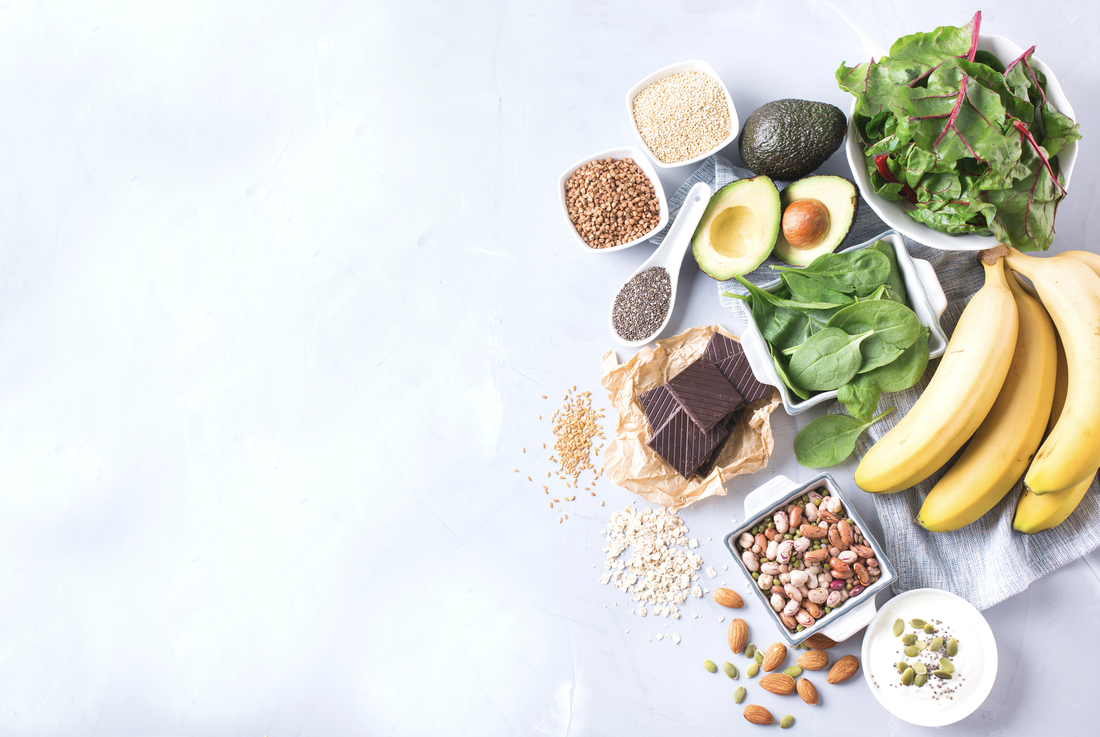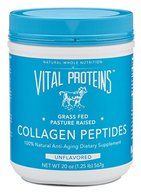|
The 2020 Simply Nourished Gift Guide is complete and full of ideas for health-conscious giving! These are some of my absolute favorite products - tried and true! Make sure to use the links and codes provided in order to get specified savings. Please know, some links simply direct you to where you can purchase the product/item from and do not have a savings amount associated. Just click on a section below to gain access to clickable links! Thank you in advance for supporting my small business and my goal to share health and healing through food-as-medicine and lifestyle approaches!
2 Comments
According to the American Association of Clinical Endocrinologists, more than 27 million Americans have thyroid-related disorders and more than half remain undiagnosed. That said, thyroid-related diseases are often poorly diagnosed and there is much surrounding their treatment that requires more in-depth clarification and individualization.
The thyroid gland is a 2-inch butterfly-shaped organ located at the front of the neck. Although small, the thyroid gland plays a major role in the endocrine system and affects nearly every organ in the body. The thyroid regulates fat and carbohydrate metabolism, respiration, body temperature, brain development, cholesterol levels, the heart and nervous system, blood calcium levels, menstrual cycles, skin integrity, and more. Common conditions associated with thyroid include Hyperthyroidism (which includes Autoimmune Thyroid Disease [AITD], Graves' Disease, and Thyroid Storm), Hypothyroidism (which includes Hashimoto's, Congenital Hypothyroidism [CHD] or cretinism, Myxdema, Thyroid Autoimmunity, Endemic Goiter, Subclinical Hypothyroidism [SCH], and Polycystic Ovary Syndrome [PCOS]). Hyperthyroidism Hyperthyroidism results from the over-secretion of the thyroid hormones, thiiodothyronine (T3) or thyroxone (T4). These hormones affect every cell as they help to control body temperature, heart rate, metabolism, production of calcitonin, and glucose homeostasis. Usually, in hyperthyroidism, the entire gland is overproducing thyroid hormone. Symptoms associated with hyperthyroidism include:
Some of the most common endocrine diseases associated with hyperthyroidism include autoimmune thyroid diseases (AITD), Graves’ disease, and chronic lymphocytic thyroiditis (CLT). Autoimmune thyroid disease (AITD) may start out as a temporary concern, but it can lead to hyperthyroidism. AITD may be associated with a Hashimoto’s thyroiditis, subacute granulomatous thyroiditis, or silent lymphocytic thyroiditis. While the causes of AITD may not be easily identifiable, functional medicine practitioners work to identify if a person may have any environmental triggers or other health-related concerns that may be associated with a diagnosis including environmental triggers (medications, infection, iodine) or previous diagnosis of celiac disease, primary biliary cirrhosis, Type 1 Diabetes Mellitus, mood disorders, psychosis, and/or Addison's disease. Graves' disease (also known as diffuse toxic goiter) is the most common type of AITD and entails a specific combination of polymorphisms for thyroglobulin and HLA-DR, as this increases the odds ratio for developing disease. Additionally, the body's autoimmune response causes the thyroid gland to produce too much T3 and T4. Note: It is common to experience periods of high and low thyroid hormone levels in those with Graves’ disease, so it may take several months to achieve a balance. Thyroid Storm (thyroid crisis) is a potentially life-threatening condition that develops in a person with hyperthyroidism where the gland suddenly releases large amounts of thyroid hormone in a short period of time. Symptoms of Thyroid Storm include:
If left untreated, Thyroid Storm can result in shock, delirium, shortness of breath, fatigue, coma, heart failure, and even death. Hypothyroidism Hypothyroidism ("underactive thyroid") is the most common thyroid condition, affects up to 10% of adult women, and is caused by the under-functioning of the thyroid gland (most common: inflammation cause by antibodies; second major cause: various medical treatments that affect thyroid gland [e.g., surgery, chronic medication use]). Hypothyroidism is classified as Primary (thyroid failure, 95% of all cases), Secondary (pituitary TSH deficient), Tertiary (hypothalamic deficiency or thyrotropin-releasing hormone), or results from peripheral resistance to the action of thyroid hormones. Hashimoto's Thyroiditis is an autoimmune response responsible for hypothyroidism in many cases and is the most common cause of thyroid gland failure. In these cases, the body mistakenly identifies its own tissues as an invader and attacks them until the organ is destroyed. This chronic attack eventually prevents the thyroid from releasing adequate levels of the hormones T3 and T4, which are necessary to keep the body functioning properly. Lack of T3 and T4 hormones can slow metabolism and cause weight gain, fatigue, dry skin and hair, and difficulty concentrating. References Canaris GJ, Manowitz NR, Mayor G, Ridgway EC. The Colorado thyroid disease prevalence study. Arch Intern Med. 2000;160(4):526-534. Hypothyroidism. Bethesda, MD: National Endocrine and Metabolic Diseases Information Service, US Dept of Health and Human Services; 2012. NIH Publication No. 12–6180. Golden SH, Robinson KA, Saldanha I, Anton B, Ladenson PW. Clinical review: prevalence and incidence of endocrine and metabolic disorders in the United States: a comprehensive review. J Clin Endocr Metab. 2009;94(6):1853-1878. Graves’ Disease. Bethesda, MD: National Endocrine and Metabolic Diseases Information Service, US Dept of Health and Human Services; 2008. NIH Publication No. 08-6217. Aschebrook-Kilfoy B, Ward MH, Sabra MM, Devesa SS. Thyroid cancer incidence patterns in the United States by histologic type, 1992-2006. Thyroid. 2011:21(2):125-134. Biondi B, Klein I. Hypothyroidism as a risk factor for cardiovascular disease. Endocrine. 2004;24(1):1-13. Duntas LH, Brenta G. The effect of thyroid disorders on lipid levels and metabolism. Med Clin North Am. 2012;96(2):269-281. Johnson JL. Diabetes control in thyroid disease. Diabetes Spectrum. 2006;19(3):148-153. Centers for Disease Control and Prevention. Second National Report on Biochemical Indicators of Diet and Nutrition in the U.S. Population. Atlanta, GA: Centers for Disease Control and Prevention, US Dept of Health and Human Services; 2012. Dean S. Medical nutrition therapy for thyroid and related disorders. In: Mahan KL, Escott-Stump S, eds. Krause’s Food, Nutrition, & Diet Therapy. 13th ed. Philadelphia, PA: Saunders; 2008: 711-724. Tamer G, Arik S, Tamer I, Coksert D. Relative vitamin D insufficiency in Hashimoto’s thyroiditis. Thyroid. 2011;21(8):891-896. Jyotsna VP, Sahoo A, Ksh SA, Sreenivas V, Gupta N. Bone mineral density in patients of Graves disease pre- & post-treatment in a predominantly vitamin D deficient population. Indian J Med Res. 2012;135(1):36-41. Rayman MP. Selenium and human health. Lancet. 2012;379(9822):1256-1268. Toulis KA, Anastasilakis AD, Tzellos TG, Goulis DG, Kouvelas D. Selenium supplementation in the treatment of Hashimoto’s thyroiditis: a systematic review and a meta-analysis. Thyroid. 2010;2010:1163-1173. Sworczak K, Wisniewski P. The role of vitamins in the prevention and treatment of thyroid disorders. Endokrynol Pol. 2011;62(4):340-344. Institute of Medicine Food and Nutrition Board. Dietary Reference Intakes for Vitamin A, Vitamin K, Arsenic, Boron, Chromium, Copper, Iodine, Iron, Manganese, Molybdenum, Nickel, Silicon, Vanadium, and Zinc. Washington, DC: National Academies Press. Rungapamestry V, Duncan AJ, Fuller Z, Ratcliffe B. Effect of cooking brassica vegetables on the subsequent hydrolysis and metabolic fate of glucosinolates. Proc Nutr Soc. 2007;66(1):69-81. Messina M, Redmond G. Effects of soy protein and soybean isoflavones on thyroid function in healthy adults and hypothyroid patients: a review of the relevant literature. Thyroid. 2006;16(3):249-258. Elnour A, Hambraeus L, Eltom M, Dramaix M, Bourdoux P. Endemic goiter with iodine sufficiency: a possible role for the consumption of pearl millet in the etiology of endemic goiter. Am J Clin Nutr. 2000;71(1):59-66. Mazokopakis EE, Giannakopoulos TG, Starakis IK. Interaction between levothyroxine and calcium carbonate. Can Fam Physician. 2008;54(1):39. Benvenga S, Bartolone L, Pappalardo MA, et al. Altered intestinal absorption of L-thyroxine caused by coffee. Thyroid. 2008;18(3):293-301. ohn-Kalarickal J, Pearlman G, Carlson HE. New medications which decrease levothyroxine absorption. Thyroid. 2007;17(8):763-765. Egert S, Rimbach G. Which sources of flavonoids: complex diets or dietary supplements? Adv Nutr. 2011;2(1):8-14. Cutovic M, Konstantinovic L, Stankovic Z, Vesovic-Potic V. Structured exercise program improves functional capacity and delays relapse in euthyroid patients with Graves’ disease. Disabil Rehabil. 2012. Textbook: Krause’s Food and Nutrition Care Process (13 edition); pp.711-730 Escott-Stump, Sylvia. Nutrition and Diagnosis-Related Care. Wolters Kluwer Health/Lippincott Williams & Wilkins, 2012. https://www.ncbi.nlm.nih.gov/pubmed/25775505 https://www.sciencedirect.com/science/article/pii/0024320589901793 https://www.ars.usda.gov/ARSUserFiles/80400525/Data/retn/retn06.pdf https://www.ncbi.nlm.nih.gov/pubmed/12405778 https://naturalmedicines.therapeuticresearch.com/ https://integrativerd.org/wp-content/uploads/2012/04/40336-DIFM-FINAL-Fall-Newsletter-E-Version-Proof-3.pdf https://www.todaysdietitian.com/newarchives/070112p40.shtml https://www.todaysdietitian.com/newarchives/1218p24.shtml https://therealfoodrds.com/how-to-improve-your-thyroid-health/ https://www.todaysdietitian.com/pdf/courses/HarrisCeliacThyroid.pdf https://integrativerd.org/wp-content/uploads/2012/04/40336-DIFM-FINAL-Fall-Newsletter-E-Version-Proof-3.pdf https://www.healthline.com/nutrition/9-foods-high-in-vitamin-d#11 https://www.healthline.com/health/hypothyroidism/symptoms-treatments-more#weight-gain https://www.healthline.com/health/selenium-foods https://www.healthline.com/nutrition/vitamin-b12-foods When it comes to preventing the spread of germs, practicing good hand hygiene is a no-brainer.
I like to carry a travel-size @branchbasics foaming soap pump when we’re out and about so I can limit our exposure to hand soaps that contain endocrine-disrupting chemicals. ⠀ However, when hand washing is not possible or you have limited access to water, hand sanitizer is great to have on hand, especially during this time. ⠀ After we ran out of our @drbronner lavender hand sanitizer (my favorite!), I searched everywhere to replenish - and everywhere was SOLD. OUT. ⠀ So, naturally, I wanted to figure it out for myself. A few simple ingredients and you have an effective, better-for-you hand sanitizer! ⠀ [A word of caution, hand sanitizer (homemade or store-bought) is not recommended for use with children as they are more prone to improper usage. That said, I recommend each parent using their best judgment and assisting children in this process to prevent over-spraying and inhalation.] ⠀ Here's a recipe you can use to make your own hand sanitizer. ⠀ //what you’ll need // ⠀ ¾ cup of 99% isopropyl or rubbing alcohol ¼ cup of organic aloe vera gel (helps to keep hands smooth + counteract the harshness of alcohol) 1 Tbsp. distilled water or colloidal silver/ionic silver 8-10 drops of organic essential oil (such as lavender or orange oil) ⠀ // directions // ⠀ 1. Pour all ingredients into a glass mixing bowl. 2. Beat with a whisk until ingredients are well-combined. 3. Using a small funnel, pour the mixture into a glass spray bottle and label it. ⠀ // make it effective // ⠀ Spray 2-3 times on hands and rub until dry. ⠀ Stay well! Peanuts (a legume) tend to get a bad rap. Much of this has to do with the way peanuts are grown as they are at greater risk for toxicity and mold (not to mention the high prevalence of allergies). Peanut butter typically has less mold than peanuts, as much is removed during processing. Peanut butter is high in fat + protein and contains only 4g net carbs and peanuts are rich in minerals (copper, manganese, molybdenum, iron) and vitamins (biotin, niacin (B3), and vitamin E).
So, when choosing peanuts/peanut butter, select organic options and always rotate nut butter use to get the most nutritional variety in your diet. For example, it's great to have almond, cashew, and peanut butter in rotation! This recipe is a great way to satisfy a sweet tooth while providing nourishing fats and protein to support mood and blood sugar levels. 1 cup natural, organic almond (or any nut) butter ½ cup natural, organic chunky peanut butter 2 Tbsp. coconut oil, melted ½ cup maple syrup 1 Tbsp. vanilla extract 1 large egg, whisked ½ tsp. sea salt 1 tsp. baking soda ¼ cup almond flour ½ cup shredded, unsweetened coconut 2 Tbsp. chia seed Pre-heat oven to 350 degrees. 1. In a mixer, add nut butter, peanut butter, coconut oil, maple syrup, and vanilla and mix on medium speed until well combined. 2. Add the whisked egg, salt, baking soda, and almond flour and mix until dough forms. 3. Line a baking sheet with parchment paper and scoop portions onto the sheet. Once all balls are placed on the baking sheet, use your fingers to press down gently until the ball flattens to about half its thickness. 3. Bake cookies for 10-12 minutes. 4. Cool, store in an air-tight glass container in the fridge. While the outbreak of the COVID-19 pandemic serves as a bit of awakening, we can utilize this time to really invest in and support our immune system through food as medicine approaches, supplementation, and mind-body modalities.
Research supports that a nutrient-dense diet has the ability to help upregulate immune function and support the body’s ability to fight-off pathogens. While these are definitely trying times, I hope this guide provides you some stability among the many unknowns. SUPPORTING RESILIENCE Resilience allows our body to remain in a state of health or recover more quickly after exposure to a virus, detrimental bacteria, or toxin(s) occurs. Both our mental health and immune system are dependent on a strong and resilient microbiome. While building resilience doesn’t occur over the short-term, there are several practices we can engage in to support our overall immunological resilience. A recent article published in JAMA found that those most susceptible to contracting COVID-19 were older adults (>65 years old) and had comorbidities such as diabetes, liver disease, and hypertension. That said, those with comorbidities or poor health at baseline had higher levels of inflammation and were more likely to contract COVID-19. Upon diagnosis, those same subjects were less resilient and often increased their risk of advancing to ARDS. Resilience is one of the foundational components of a healthy gut ecosystem. The gut microbiota is very diverse, varies between individuals, and can change over time – especially during early stages of development and during the progression of disease. Trillions of microbes inhabit the intestines form a complex ecological community that influences both normal physiology and susceptibility to disease. Regular, intentional practices can help to set a strong foundation and support our body’s resilience when it comes to contracting COVID-19 (or a virus in general). THE IMMUNE SYSTEM A well-functioning immune system is critical for survival. Our skin and mucous membranes serve as our first line of defense against foreign invaders by blocking pathogens from entering our body. Our next line of defense are the many chemicals that help to ward off viruses, harmful bacteria, fungi, parasites, and toxins (i.e. saliva, mucous, sweat, and gastric acid). Each of these mechanisms are designed to trap foreign material and wash or move it out of the body via coughing, sneezing, etc. or contain antimicrobials, acids, or enzymes to inhibit the growth of or destroy microorganisms. Additionally, dietary nutrients play a vital role in these processes. Iron is essential for differentiation and growth of epithelial tissue. Vitamin A and zinc are important for structural and function integrity of skin and mucosal cells. Vitamin D and zinc are important for structural and function integrity of skin and mucosal cells. Vitamins D, A, B6, and B12 and folate (B9) are essential for composition of intestinal microbiota. Vitamin C is necessary for promotion of collagen synthesis, keratinocyte differentiation, lipid synthesis, and fibroblast proliferation and migration. Vitamins C and E, as dietary or exogenous antioxidants, help to protect cell membranes from damage caused by free radicals generated during metabolism, toxin exposure, and pollutants. Antioxidants are necessary for the reduction of increased concentrations of reactive oxygen species [ROS] to protect cells against damage and restore cell signaling. Calcitriol (active form of vitamin D) helps to protect the lungs from infection by stimulating the expression of antimicrobial peptides in epithelial cells (i.e. cells lining the respiratory tract), stimulate tight junction protein expression in the gastrointestinal tract (GIT), and maintain renal epithelial barrier function, and enhance corneal epithelial barrier function. The GIT serves as a critical line of defense in providing both a physical and biochemical barrier and works together with gut microflora and immune cells to strengthen the gut barrier, fight-off pathogens, and limit direct contact with epithelium. The cells of our immune system include those of the innate and adaptive (or ‘acquired’) immune response. The innate immune response is the first response to an invading pathogen and includes phagocytes, neutrophils, dendritic cells, mast cells, and eosinophils, among others. While the innate response occurs quickly, the adaptive immune response is more specialized and often more effective. Adaptive immunity, although a much slower process, helps to defend the body against specific invaders. The adaptive immune response receives signals from innate cells to expand controlled lymphocyte response to bacterial and metabolic factors. It also has the ability to specifically recognize a pathogen and ‘remember’ it if exposure were to occur again. This immune response includes T-cells (critical in antigen recognition and coordination of immune response) as well as T helper (Th) cells (help to coordinate responses of other immune cells), T regulatory (Treg) cells (vital in maintaining immune tolerance to allow the immune system to ignore non-harmful, non-self antigens (e.g., food, pollen, and environmental antigens. When it comes to nutrition, making conscious decisions to best support your immune system is key. Adequate and appropriate nutrition is required for cell function optimization, including immune system cells. Regarding immunological outcomes, optimal nutrition supports the function of immune cells and their response to pathogens and inflammation. Immune function can be negatively affected by undernutrition whether the cause be malnutrition, food shortages, or famines (often observed in developing countries), and depends on factors such as age, presence of infection, nutrient interactions, and comorbidities. Additionally, single micronutrients can exert multiple diverse immunological effects on the body. If deficiency exists, multiple systems can be negatively influenced. For example, because vitamin E plays an antioxidant role, is an inhibitor of protein kinase C activity, and interacts with enzymes and transport proteins, deficiency may cause a domino effect in negative outcomes of these activities. That said, excessive intake of some nutrients can also be associated with impaired immune response. The majority of immune cells within the body are located within the gut-associated lymphoid tissue (GALT). When we consume food, our immune system works to both tolerate and digest food proteins and bacteria through the GALT as it contains both sensing and effector immune functions. Within the gut lumen, the gut microbiome provides antigens and signals with the ability to interact with both resident and systemic immune cells. The food we ingest and exposure to environmental factors have the ability to change the composition of the gut microbiome over time (favorably or unfavorably). Key dietary components that play a favorable role on the gut microbiome include probiotics and prebiotics. Notably, there may be cases where GALT immune cells come into direct contact with the gut microbiota or nutrients (for example, leaky gut). Further, significant changes in gut permeability may also be influenced by our micronutrient status (for example, low vitamin D). Studies have suggested that probiotic bacteria reduce gut inflammation with reductions in pro-inflammatory Th1 and Th17 cytokines and enhanced production of inflammation resolving cytokine IL-10. Additionally, prebiotics can enhance barrier function and provide optimal terrain for beneficial bacterial metabolism. Clinical micronutrient deficiencies can adversely affect the immune system and predispose individuals to infections and has been associated with increased morbidity and mortality in the presence of pneumonia, measles, and diarrheal disease, even in industrialized countries. In order to achieve ideal immune function, optimal levels of micronutrients are required. Optimal micronutrient status can be affected by factors contributing to increased oxidative stress including limited intake of or lack of access to nourishing food sources, lifestyle choices (including vegetarianism or veganism), emotional/financial/chemical stress, lack of or poor sleep quality, and/or limited physical activity. Additionally, certain health conditions (e.g. diabetes, obesity, etc.), genetic factors/polymorphisms, seasonal changes, and air pollution can play a role in unfavorable micronutrient status outcomes. When exposed to a pathogen, the body may lose micronutrients (such as vitamins A, C, and E, calcium, zinc, and iron) and cause the immune system to become increasingly active. That said, adequate micronutrient intake from whole, nourishing food sources is essential both prevent and aid in recovery from infection. PROBIOTICS + PREBIOTICS The GALT serves as the largest immune organ in the body and resides in the gut microbiome. In fact, about 80% of our immune system is located in the gut (roughly 3-5 pounds of bacteria live there!). The bacteria that reside in the large intestine play a significant role in our protection against pathogens through stimulation of our innate immune response. Intentional nutrition can help to enhance and support the microbiome of our gut. Probiotics are live microorganisms, which, when consumed in adequate amounts, confer a health benefit of the host. Clinical research (including double-blind randomized control trials) shows that probiotics support both the innate and acquired immune system through ‘feeding and nourishing’ the gut. Probiotics also provide synergistic effects and not only help with immune enhancement but also support other favorable health outcomes (e.g., gut healing, less bloat, enhanced mood, etc.). Prebiotics are a substrate that is selectively utilized by host microorganisms conferring a health benefit. Prebiotics are fibers that tend to be non-digestible (i.e. oligosaccharides such as fructo-oligosaccharides and galacto-oligosaccharides) but are metabolized by the colonic microbiome which releases certain metabolites including short-chain fatty acids (SCFSAs). The combination of prebiotics and probiotics is called symbiotics. And, specific probiotics, prebiotics, or their combination significantly influence host immunological networks. Eating a nourishing, balanced diet rich in fiber, colors, and foods that provide us both prebiotics and probiotics can help us to accomplish an establishment of optimal gut microbiota. Probiotic-rich foods include kombucha (some have added expectorants to provide more anti-inflammatory support, antimicrobials, and immune enhancers such as cayenne and ginger), sauerkraut, (1 Tbsp. provides ~10 million to 10 billion CFU’s), kimchi, kefir, unpasteurized pickled vegetables, etc. Prebiotic-rich foods include garlic, onions, leeks, asparagus, apples, organic apple cider vinegar, and more. You may consider opting for non-dairy yogurt, especially if experiencing upper respiratory symptoms, as dairy can drive phlegm and mucous production and may interfere with your body’s ability to clear bacteria and pathogens. If opting for probiotic supplementation, consider a formula that includes the strains Lactobacillus acidophilus and Bifidobacterium lactis as they have been shown to enhance immune function. BONE BROTH Although seemingly a recent practice, homemade bone broth has been around for centuries. Bone broth contains supports the GALT and contains NAC (N-Acetyl Cysteine), which is a compound found in many bronchitis medications and works as an expectorant to break-up phlegm and mucous in the chest. Research has shown it to increase white blood cells (our immune system's army of defense). Additionally, bone broth contains collagen and gelatin; both have excellent gut healing properties and provide nourishing calories through protein and fat. Bone broth can be made at home from the carcass/bones of chicken, turkey, or beef with filtered water, onions, carrots (or other root veggies), herbs, spices, and a bit of apple cider vinegar (which helps to extract minerals from the bones and create a more nutrient-dense broth). The broth should be cooked low and slow (for at least 24 hours) for optimal benefits. Otherwise, you can purchase bone broth from the grocery store. High-quality brands to consider (look for the “jiggle” when cooled): Bonafide Provisions – found in freezer section, Kettle and Fire, EPIC Provisions, etc. VITAMIN D Research has shown that vitamin D plays a role in immune function and our ability to fight infections by modulating both the innate and adaptive immune responses. Vitamin D helps to decrease inflammation by increasing anti-inflammatory cytokines and decreasing pro-inflammatory cytokine expression. Additionally, vitamin D receptor (CDR) is present in most immune cells. Vitamin D has antiviral, antimicrobial, and prohormone properties and has been shown to protect against upper respiratory infections by calming a pathogen and fight against bacteria and viruses. Adequate intakes support our innate immune system and works as a prohormone (which supports a healthy brain, metabolism, thyroid function, bone health, etc.). Regarding COVID-19, research has identified that the virus likely enters the body through the ACE2 (angiotensin-converting enzyme 2) receptor and animal studies have displayed that calcitriol (active form of vitamin D) increases both VDR and protein levels of ACE2. Further, a recent study published in the BMJ demonstrated that vitamin D supplementation decreased the risk of respiratory tract infections by 50% in those that were deficient and 10% in those with favorable vitamin D status. Excellent sources of vitamin D include wild-caught fish such as salmon (contains 3x the amount of vitamin D [IU’s] per serving vs. farmed salmon), fatty fish (look for BPA-free cans or pouches, if possible), pastured eggs (vitamin D levels in egg yolk depend on the content of feed as well as sunlight exposure; pastured eggs contain 3-4x higher vitamin D levels vs. non-pastured), beef liver, cod liver oil, mushrooms, etc. Beyond food sources (and depending on climate allowance), sunlight offers a natural and easy way for the body to absorb this essential vitamin. If warranted, additional supplementation of 1,000-5,000 IUs of cholecalciferol (vitamin D3) per day (depending on current levels) should be considered and individualized. If possible, find a vitamin D supplement that contains both K1 and K2 as this offers no risk of calcification of soft tissues and ensures that the vitamin D is metabolized appropriately. Additionally, if you experience symptoms or are currently sick, you may consider increasing your daily dosage. Note: It is recommended that you discuss appropriate dosing, long-term use, and general supplementation information with a qualified healthcare practitioner. VITAMIN C If you are consuming a nutrient-dense diet that includes both fruit and vegetables in a variety of colors, you are likely to meet the daily recommended amount of vitamin C (aka ascorbic acid). Vitamin C is widely recognized as a powerful antioxidant, supports both the innate and adaptive immune response, and supports the adrenal glands through metabolism of cortisol (primary stress hormone) in the body to curb the stress response (adrenal glands also store the most vitamin C in the body!). Additionally, clinical research indicates low levels of vitamin C leads to increased susceptibility to virus and infection and compromised immune health. Food sources of vitamin C include bell peppers (one green bell pepper contains 96 mg, one yellow bell pepper contains 340 mg, one red bell pepper contains 209 mg), citrus fruits (oranges [one medium orange contains 70 mg], lemons, limes, grapefruit; the rind also has bioflavonoids), other tropical fruits (e.g., kiwi, pineapple, guava, mango), berries (e.g., strawberry, blueberry, raspberry; berries are also a low-glycemic choice), broccoli, Brussels sprouts, and leafy greens (e.g., kale, collards). Acerola cherry is the most potent form of whole food vitamin C. Vitamin C supplementation may be beneficial in small, divided doses of about 500 mg throughout the day. Divided doses are vital to decrease the likelihood of soft stool (so pay attention to stool patterns). Notably, because this vitamin is water-soluble, no risk of toxicity exists. If supplementing, consider liposomal forms (liquid form) as it is more easily delivered and absorbed than capsules and tablets. ZINC Zinc is a powerful antioxidant and is required to activate certain immune cells. Zinc deficiency is associated with impaired immune function and increased risk of infections such as pneumonia in certain groups. Deficiency is also often associated with decreases in immune cell development, innate immune cell function, adaptive immunity through T helper cells. A randomized, double-blind trial concluded that after 45 mg/day of zinc supplementation, the incidence of infections was significantly lower, plasma zinc was significantly higher, and the generation of TNF-alpha and oxidative stress markers was significantly lower vs. the placebo group. Another randomized, double-blind, placebo-controlled trial revealed that 30 mg/day of zinc supplementation (for 3 months), enhanced T cell function and serum zinc concentrations. Adequate daily zinc intake, whether through dietary sources or supplementation is critical. Food sources of zinc include seafood (crab, lobster oysters, etc.), grass-fed beef, organic chicken (dark meat), raw pumpkin seeds, yogurt, raw cashews, and chickpeas. If supplementing, be cautious with dosage; taking greater than 100 mg per day can increase your risk of prostate cancer, fever, chills, and/or headaches. Consider having a micronutrient panel ran to accurately determine your zinc level and supplement for 2 weeks and then recheck as long-term zinc supplementation may cause copper deficiency. If supplementing, while zinc lozenges have been shown to have higher absorption, some people experience nausea, vomiting, upset stomach, and/or diarrhea. QUERCETIN Quercetin, a polyphenol derived from plants, has been shown to reduce the incidence and severity of upper respiratory tract infection symptoms and may provide additional immune-boosting effects when combined with vitamin C. Additionally, in vitro and animal models have shown that quercetin has a range of biological actions including anti-carcinogenic, anti-inflammatory and antiviral activities; as well as attenuating lipid peroxidation, platelet aggregation, and capillary permeability. Food sources include apples, berries, Brassica vegetables (e.g., broccoli, cauliflower, Brussels sprouts, cabbage, turnips/turnip greens, collards, kale, bok choy), capers, grapes, onions, shallots, tea, tomatoes, seeds, nuts, black tea, oranges, honey, etc. In red onions, the highest concentrations of quercetin are found in the outermost rings and the part closest to the root (which holds the greatest concentrations). Interestingly, a study found that organically grown tomatoes had 79% more quercetin than conventionally-grown tomatoes. The highest concentration of quercetin found in food sources is 234 mg per 100 grams of raw capers (edible portion) while lowest concentrations are found in black or green tea (2 mg per 100 grams). Quercetin is also found in medicinal botanicals including Ginkgo biloba, Hypericum perforatum, and Sambucus canadensis. BLACK + GREEN TEA Black and green tea come from the same plant, Camelia sinensis, an evergreen shrub that grows in mountainous areas. The primary difference is what happens after the leaves are harvested and allowed to wilt (green tea: leaves are quickly steamed or heated to stop oxidation; black tea: leaves are crushed, torn, curled, or rolled and allowed to oxidize before being dried). That said, black tea has slightly lower flavonoid amounts than green tea. Both black and green tea contain polyphenols, which help to support a healthy gut microbiome and help to bind to a virus and reduce the ability for the virus to replicate. A Harvard research study determined that consuming 5 cups per day increased the virus-fighting compound, interferon by ten times! Green tea contains theanine as well as epigallocatechine-3-gallate (EGCG), which, in animal studies, has been shown to modulate innate and adaptive immunity. These studies have also shown to inhibit cytokine production and T cell proliferation. Synergistically, several large, population-based studies suggest that drinking green or black tea may lessen the occurrence of heart attacks and strokes. Enjoy 1-2 cups of organic green or black tea per day as a nourishing way to unwind and possibly support upper respiratory health. OMEGA-3s Omega-3 polyunsaturated fatty acids are essential fatty acids. This means that the body cannot produce these fatty acids itself and must obtain them exogenously (through the diet or supplementation). Omega-3 fatty acids serve as nourishing calories and are primary building blocks of the immune system. Omega-3 fatty acids directly influence T cells and play a role in inhibiting the production of inflammatory mediators. Among the omega-3 polyunsaturated fatty acids (PUFAs), eicosapentaenoic acid (EPA) and docosahexaenoic acid (DHA) are the primary bioactive forms in humans. Both EPA and DHA help to reduce neutrophil infiltration and the inflammatory response. EPA and DHA can be synthesized from alpha-linolenic acid (ALA). However, this conversion requires several chemical reactions and is less efficient in mammals. That said, the consumption of EPA- and DHA-rich foods is recommended. Literature supports favorable outcomes of omega-3 PUFAs intake and the inflammatory response. It is also well-understood that omega-3s also provide multiple health benefits against chronic disease including inflammatory bowel disease, depression, cancer, cardiovascular diseases, and rheumatoid arthritis. Consume 2-4 servings of wild-caught fish per week including wild-caught salmon, sardines, mussels, herring, and anchovies. Plant-based sources of the precursor to EPA and DHA include chia seeds, ground flaxseed, hemp seeds, and walnuts. If you struggle to consume the recommended daily amounts of omega-3’s through food sources, consider supplementing your diet with a high-quality fish oil capsule or liquid. Note: Be sure to discuss omega-3 supplementation with a health care practitioner if you are currently taking glucocorticoids. GINGER Ginger has antimicrobial, antifungal, and antiviral properties. Ginger root supplementation has been shown to have a significant effect on lowering CRP, TNF alpha, and Interleukin-6 (IL-6), offering anti-inflammatory and immune-boosting benefits. An analysis further indicated that ginger supplementation has significant effects on serum inflammatory and oxidative stress markers. Ginger root can be purchased at your local grocery store or farmers market and can be stored in the freezer as needed. Choose fresh ginger root vs. the powdered version as it is more potent and less ‘processed’. However, if finding fresh ginger is difficult, powdered ginger can be substituted. GARLIC Literature details the use of garlic (Allium sativum) to combat infectious disease for centuries. Garlic has been used to treat and prevent respiratory infection. Garlic contains alliin and allicin, which are compounds that have antimicrobial properties. While there isn’t strong evidence on the impact of garlic, the studies that have been conducted suggest garlic may stimulate the immune system and have antimicrobial actions as well as lower inflammation, cholesterol, and blood pressure. Garlic can be added to many entrees, side dishes, broths, and beverages. When using fresh garlic, peel each clove and either smash or chop with a chef’s knife and allow to sit for 10-15 minutes. This allows the garlic to oxidize and increase allicin compounds. The addition of even 1-2 cloves of fresh garlic offers an antimicrobial and gut-friendly boost. Note: Be sure to discuss increased garlic use (or supplementation) with a health care practitioner if you are currently taking a blood thinner, insulin, or protease inhibitors. ADDITIONAL HERBS + ADAPTOGENS TO CONSIDER Fresh, organic herbs are a great way to include antimicrobial, antifungal, and antiviral properties in cooking or beverages. Examples include ginger (as referenced previously), thyme, garlic (as referenced previously), etc. Additionally, thyme, oregano, lemon balm, and sage have been shown to fight against viruses and pathogens and also work favorably in ear, nose, and throat areas. Adaptogens, including holy basil, ashwagandha, medicinal mushrooms (reishi, in particular [Gandoderma ludicum]) are often used to support immune health and resilience. Astragalus is one of the most vital herbs in Traditional Chinese Medicine and has immune enhancing effects. Traditionally, astragalus was used as part as general lifestyle practices and featured in soups and medicinal teas and provide significant protection against heart, brain, liver, kidney, intestine, and lung injury in various models of oxidative stress-related disease. Additionally, isolated constituents of Astragalus displayed significant prevention of tissue injury through antioxidant mechanisms. Notably, astragalus is not traditionally used during a fever. Echinacea has been traditionally recommended for the prevention and treatment of the common cold. Studies indicate that the herb provides favorable outcomes. However, statistically significant data is lacking at this time. Echinacea has been shown to be safe for most people and outcomes favor the prevention of upper respiratory infection and recurrent infection. When used prophylactically, echinacea can help to prevent the common cold. Echinacea use has been shown to be generally safe during pregnancy and breastfeeding. Dosing recommendations include 300-500 mg of dried herb, three times per day (tablet or capsule) or 2.5-5 mL of tincture up to 3 times per day. Studies focusing on reishi have discovered its ability to calm an overstimulated immune response, regulating the immune system, and enhance reduced immune function. Adaptogen use, in general, has revealed favorable outcomes when mood, anxiety, and overall well-being were studied. Note: Be sure to discuss increased herbal/medicinal mushroom/adaptogen use with a health care practitioner if you are pregnant, on immunosuppressive medications, or have autoimmune conditions. Doses vary so be sure to discuss with a qualified health care practitioner. Regarding echinacea, people with chronic systemic autoimmune conditions, on immunosuppressive medications, and who have experienced unfavorable symptom flares, should avoid use or use or discuss with health care provider. SLEEP QUALITY + QUANTITY Sleep quality and quantity play a significant role in immune health, overall. Lack of adequate sleep practices has been shown to increase our susceptibility to viruses and pathogens and can impair our overall immune response and increase our inflammatory response. Optimal rest is key for immune support, especially if you start to feel under the weather. Aim for at least 7-9 hours of quality rest, per night. MIND-BODY PRACTICES TO STRENGTHEN YOUR IMMUNE SYSTEM Deep breathing Not only is deep breathing excellent for calming the mind and body during times of stress, it supplies more oxygen to the body including the digestive system. The increased blood flow encourages intestinal response/action and works to enhance overall digestion (hence the phrase: rest and digest). Use the 4-7-8 deep breathing technique:
Physical activity The behavior of almost all immune cell populations in the bloodstream is altered in some way during and after exercise. Studies indicate that exercise participation may in fact reduce the incidence of infections. A prospective cohort study of 1,509 Swedish men and women aged 20–60 years found that higher physical activity levels were associated with a lower incidence of self-reported upper respiratory tract infections (URTIs). Additionally, evidence from epidemiological studies shows that regular physical activity reduces the incidence of communicable (e.g., bacterial and viral infections) and non-communicable diseases (e.g., cancer). This implies that immune competency is enhanced by regular exercise bouts. Further, regular physical activity has been demonstrated to limit or delay immunological aging. Aim for a variety of regular, enjoyable movements including movements that include both static and dynamic stretching/movements, yoga, tai chi, Pilates, cardiovascular training, resistance training, etc. Should you have general questions related to optimizing your immune health or supplement recommendations, please contact me. For updates and more food as medicine approaches, be sure to follow along on Facebook and Instagram. Please note, this article was written for general education purposes by an integrative registered dietitian. Questions pertaining to your health care needs and supplement needs should be discussed with your health care provider. REFERENCES
Did you know migraine is the 3rd most prevalent illness in the world and affects 12% of the US population?
Migraines are the seventh leading cause of years lived with disability, with a worldwide prevalence estimated at 11.6% (greater than 20% of chronic migraine sufferers are disabled and the likelihood of disability increases with the number of comorbid conditions). Migraines are most commonly experienced between the ages of 18-44 years and not only affect men and women, but children as well.
For many migraine sufferers, migraine is a chronic disease that significantly decreases their quality of life and the overuse of medication is the most common reason episodic migraines turn chronic. Interestingly, other common ailments for those with chronic migraine include anxiety, depression, and sleep disturbances. what is a migraine? A migraine is a common condition characterized by recurrent, throbbing headaches which include moderate to severe pain that can last up to three days. Migraine sufferers also report symptoms such as photophobia (light sensitivity), phonophobia (anxiety disorder/fear of loud sounds), and nausea. Common migraine-associated signs/symptoms:
**may occur right before or during a migraine (aura) Migraines are often undiagnosed and untreated. Diagnosis of migraines is highly individualized and is often based on a person’s symptoms. potential migraine causes + triggers Potential migraine triggers include:
With this, the expression of a migraine may be influenced by specific dietary and/or nutrition-related factors that can play a role in inflammation, vasodilation, glucose metabolism, and attack frequency/severity. Many foods are known to cause neurovascular and neurochemical effects in individuals prone to migraines either directly (i.e. endogenous or artificial chemicals) or indirectly (release of immune mediators such as inflammatory cytokines). Examples of endogenous chemicals are the amines:
Additionally, food additives such as nitrates (often found in processed meats) and MSG (found in meat tenderizer, soy sauce, Asian foods, and a variety of packaged foods) have also been associated with the presentation of migraines. Other food substances often considered to be triggers include tannins and phenols found in:
Other diet-related factors that may be associated with increased expression of migraine symptoms includes:
common food-related migraine triggers
determining food triggers + cause When it comes to determining the root cause of migraines, there is much controversy as to what exactly to consider. How a practitioner accurately determines the specific food triggers and/or nutrition intervention to mitigate or eliminate migraines is still inconclusive. There's a lot of discussion as to whether or not dietary intervention and/or elimination protocols are an appropriate, successful intervention in migraine prevention. Emerging studies have identified support for the role of comprehensive diets in the prevention of migraines (performed under the care of a credentialed practitioner ensuring adequate macronutrient and vitamin/mineral intakes). It has also been reported that a diet rich in omega-3 and low in omega-6 polyunsaturated fatty acids (PUFAs) appeared to decrease migraine frequency. It may also be possible that a migraine is associated with a woman’s menstrual cycle, celiac disease, gluten sensitivity, or vitamin and mineral deficiencies, which is why an in-depth symptom diary and health history is vital for a practitioner in getting to the root-cause of the presenting migraine. Migraines can also be triggered by impingement of the vertebral artery which is encased in the first 6 cervical (neck) bones of the neck. Finally, keep in mind food sensitivities can be dose-dependent. This means that a client may experience symptoms with a certain amount of a specific food consumed (e.g. ¼ cup nuts = no symptoms vs. 1 cup nuts = symptoms present). what you can do... Because there are so many 'unknowns'' surrounding migraine, a full evaluation by a licensed chiropractor and integrative dietitian is a great place to start. Practitioners who focus on a root-cause approach can help to identify triggers or 'blindspots', address these areas, or suggest further testing. Once environmental, lifestyle, and hormonal factors have been ruled-out, a practitioner may suggest nutrition intervention in which the elimination of food triggers is used. If, after an introductory elimination diet is implemented and migraines persist, Mediator Release Testing (MRT) and a Lifestyle Eating and Performance (LEAP) dietary approach may help to identify food sensitivities that are contributing to migraine symptoms and allow a practitioner to suggest a more long-term approach to eating to best support the clients and his/her nutrition needs and symptoms. Testing to identify food allergies and/or sensitivities can be useful in identifying an appropriate anti-inflammatory or anti-migraine diet. MRT and the LEAP protocol help to correctly identify foods or food chemicals that may be responsible for symptoms/hypersensitivity reactions and give the practitioner a framework for constructing a diet plan that will be beneficial for the client using ‘safe foods’. The key? Every body is different. It may take time to experience symptom relief, identify triggers, etc. nutrition + lifestyle practices to consider
supplementation considerations
For a complete nutrition assessment including nutrition-focused examination, recommendations, and more information on lab testing, contact our us! [notes: this post was also shared on The Wellness Pointe's blog page as a guest blog post.]
Struggling to find the right gift for a friend who 'has everything'?! I've pieced together some of my favorites... everything from real-food bars to comfy, high-performance socks to the best coconut oil for keeping skin oh-so-soft during these winter months. Enjoy!
With an (almost) 2-year-old at home, career, and "life" in general, I've added some of the things I've found to be most practical for me over the past year. Below are my favorite finds - perfect for your wife/mother/sister/daughter/friend who's always on-the-go! Enjoy!
Still in search of the perfect gift for the person that most enjoys their time in the kitchen? I've curated some of my favorite finds below. Enjoy!
|
Samantha Schleiger, MS, RDN, CD, CLTSam is a functional nutrition dietitian, certified LEAP therapist, and functional medicine beneficiary. Sam's passion for teaching others how to use food as medicine and mind-body modalities stems from her experience as an athlete and her personal experience of using functional medicine to identify the root cause of and heal her IBS, leaky gut, and food sensitivities. archives
December 2020
categories
All
|
LOCATION5 RIDGWAY COURT, SUITE B, ELKHORN, WI 53121
[email protected] |
|






































 RSS Feed
RSS Feed